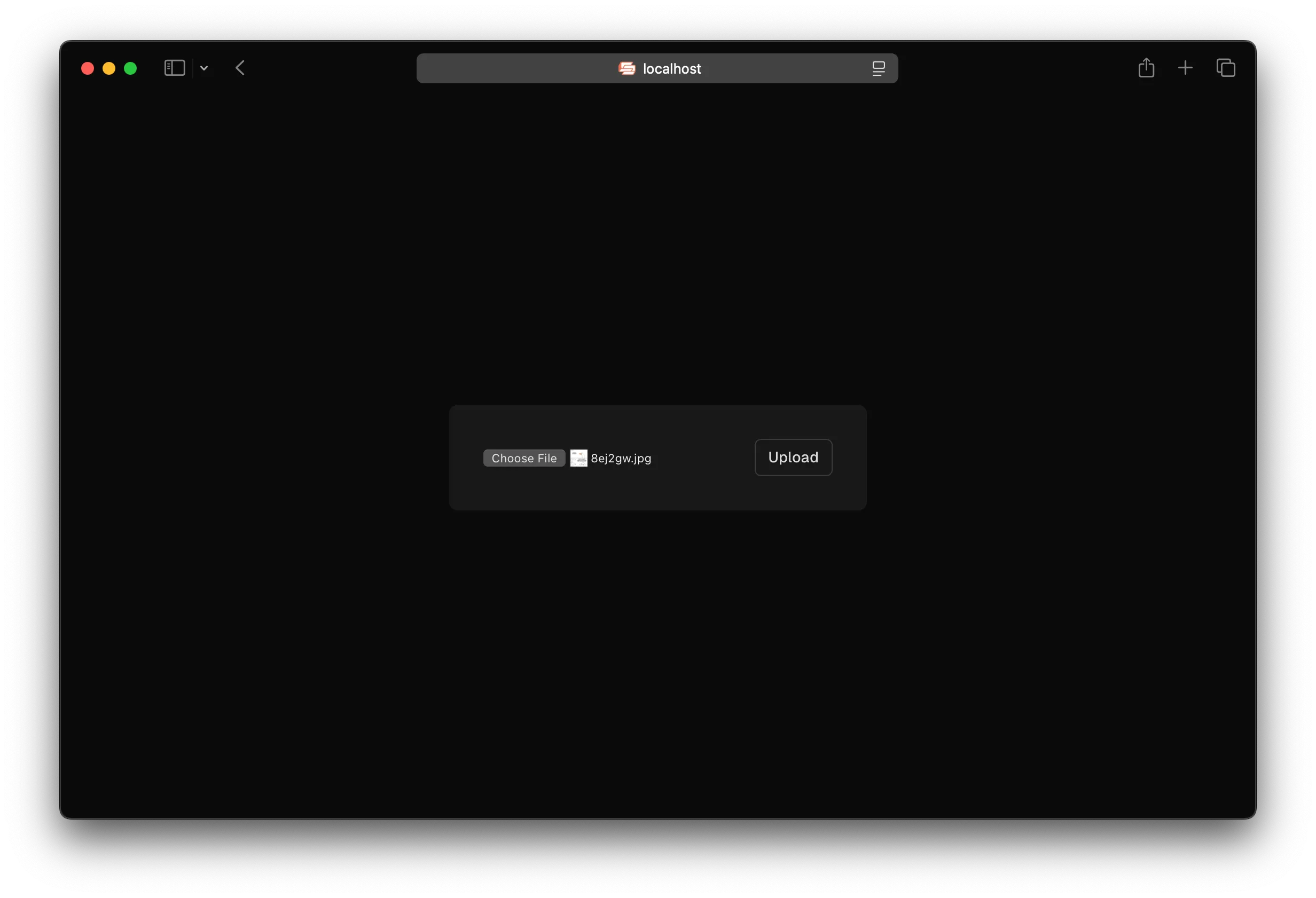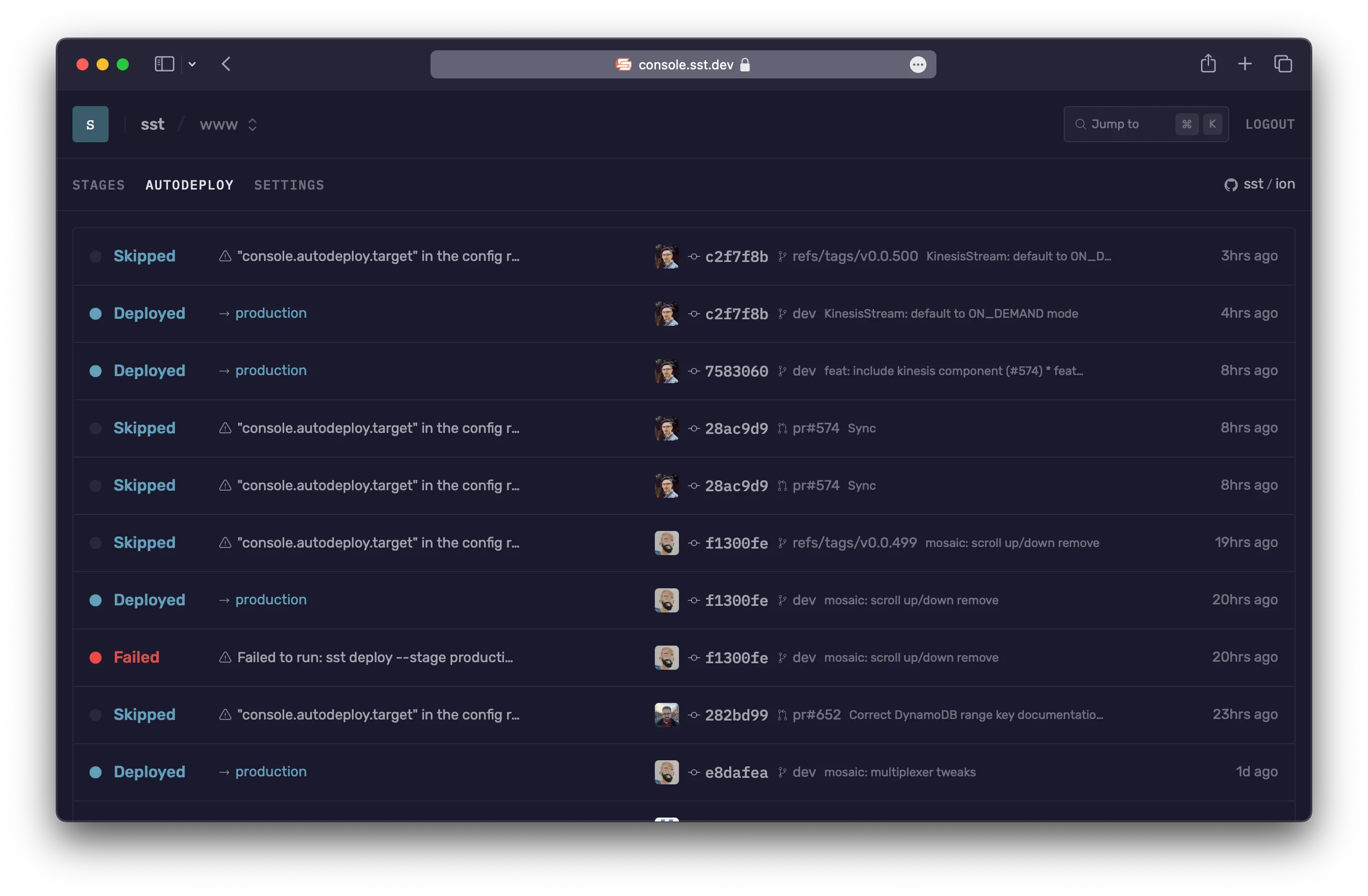Next.js on AWS with SST
There are two ways to deploy a Next.js app to AWS with SST.
We’ll use both to build a couple of simple apps below.
Examples
We also have a few other Next.js examples that you can refer to.
- Adding basic auth to your Next.js app
- Enabling streaming in your Next.js app
- Add additional routes to the Next.js CDN
- Hit counter with Redis and Next.js in a container
Serverless
We are going to create a Next.js app, add an S3 Bucket for file uploads, and deploy it using OpenNext and the Nextjs component.
Before you get started, make sure to configure your AWS credentials.
1. Create a project
Let’s start by creating our app.
npx create-next-app@latest aws-nextjscd aws-nextjsWe are picking TypeScript and not selecting ESLint.
Init SST
Now let’s initialize SST in our app.
npx sst@latest initSelect the defaults and pick AWS. This’ll create a sst.config.ts file in your project root.
Start dev mode
Run the following to start dev mode. This’ll start SST and your Next.js app.
npx sst devOnce complete, click on MyWeb in the sidebar and open your Next.js app in your browser.
2. Add an S3 Bucket
Let’s allow public access to our S3 Bucket for file uploads. Update your sst.config.ts.
const bucket = new sst.aws.Bucket("MyBucket", { access: "public"});Add this above the Nextjs component.
Link the bucket
Now, link the bucket to our Next.js app.
new sst.aws.Nextjs("MyWeb", { link: [bucket]});3. Create an upload form
Add a form client component in components/form.tsx.
"use client";
import styles from "./form.module.css";
export default function Form({ url }: { url: string }) { return ( <form className={styles.form} onSubmit={async (e) => { e.preventDefault();
const file = (e.target as HTMLFormElement).file.files?.[0] ?? null;
const image = await fetch(url, { body: file, method: "PUT", headers: { "Content-Type": file.type, "Content-Disposition": `attachment; filename="${file.name}"`, }, });
window.location.href = image.url.split("?")[0]; }} > <input name="file" type="file" accept="image/png, image/jpeg" /> <button type="submit">Upload</button> </form> );}Add some styles.
.form { padding: 2rem; border-radius: 0.5rem; background-color: var(--gray-alpha-100);}
.form input { margin-right: 1rem;}
.form button { appearance: none; padding: 0.5rem 0.75rem; font-weight: 500; font-size: 0.875rem; border-radius: 0.375rem; background-color: transparent; font-family: var(--font-geist-sans); border: 1px solid var(--gray-alpha-200);}
.form button:active:enabled { background-color: var(--gray-alpha-200);}4. Generate a pre-signed URL
When our app loads, we’ll generate a pre-signed URL for the file upload and render the form with it. Replace your Home component in app/page.tsx.
export const dynamic = "force-dynamic";
export default async function Home() { const command = new PutObjectCommand({ Key: crypto.randomUUID(), Bucket: Resource.MyBucket.name, }); const url = await getSignedUrl(new S3Client({}), command);
return ( <div className={styles.page}> <main className={styles.main}> <Form url={url} /> </main> </div> );}We need the force-dynamic because we don’t want Next.js to cache the pre-signed URL.
Add the relevant imports.
import { Resource } from "sst";import Form from "@/components/form";import { getSignedUrl } from "@aws-sdk/s3-request-presigner";import { S3Client, PutObjectCommand } from "@aws-sdk/client-s3";And install the npm packages.
npm install @aws-sdk/client-s3 @aws-sdk/s3-request-presignerTest your app
Head over to the local Next.js app in your browser, http://localhost:3000 and try uploading an image. You should see it upload and then download the image.

5. Deploy your app
Now let’s deploy your app to AWS.
npx sst deploy --stage productionYou can use any stage name here but it’s good to create a new stage for production.
Congrats! Your app should now be live!
Containers
We are going to create a Next.js app, add an S3 Bucket for file uploads, and deploy it in a container with the Cluster component.
Before you get started, make sure to configure your AWS credentials.
1. Create a project
Let’s start by creating our app.
npx create-next-app@latest aws-nextjs-containercd aws-nextjs-containerWe are picking TypeScript and not selecting ESLint.
Init SST
Now let’s initialize SST in our app.
npx sst@latest initSelect the defaults and pick AWS. This’ll create a sst.config.ts file in your project root.
2. Add a Service
To deploy our Next.js app in a container, we’ll use AWS Fargate with Amazon ECS. Replace the run function in your sst.config.ts.
async run() { const vpc = new sst.aws.Vpc("MyVpc"); const cluster = new sst.aws.Cluster("MyCluster", { vpc });
new sst.aws.Service("MyService", { cluster, loadBalancer: { ports: [{ listen: "80/http", forward: "3000/http" }], }, dev: { command: "npm run dev", }, });}This creates a VPC, and an ECS Cluster with a Fargate service in it.
The dev.command tells SST to instead run our Next.js app locally in dev mode.
Start dev mode
Run the following to start dev mode. This’ll start SST and your Next.js app.
npx sst devOnce complete, click on MyService in the sidebar and open your Next.js app in your browser.
3. Add an S3 Bucket
Let’s allow public access to our S3 Bucket for file uploads. Update your sst.config.ts.
const bucket = new sst.aws.Bucket("MyBucket", { access: "public"});Add this below the Vpc component.
Link the bucket
Now, link the bucket to the container.
new sst.aws.Service("MyService", { // ... link: [bucket],});This will allow us to reference the bucket in our Next.js app.
4. Create an upload form
Add a form client component in components/form.tsx.
"use client";
import styles from "./form.module.css";
export default function Form({ url }: { url: string }) { return ( <form className={styles.form} onSubmit={async (e) => { e.preventDefault();
const file = (e.target as HTMLFormElement).file.files?.[0] ?? null;
const image = await fetch(url, { body: file, method: "PUT", headers: { "Content-Type": file.type, "Content-Disposition": `attachment; filename="${file.name}"`, }, });
window.location.href = image.url.split("?")[0]; }} > <input name="file" type="file" accept="image/png, image/jpeg" /> <button type="submit">Upload</button> </form> );}Add some styles.
.form { padding: 2rem; border-radius: 0.5rem; background-color: var(--gray-alpha-100);}
.form input { margin-right: 1rem;}
.form button { appearance: none; padding: 0.5rem 0.75rem; font-weight: 500; font-size: 0.875rem; border-radius: 0.375rem; background-color: transparent; font-family: var(--font-geist-sans); border: 1px solid var(--gray-alpha-200);}
.form button:active:enabled { background-color: var(--gray-alpha-200);}5. Generate a pre-signed URL
When our app loads, we’ll generate a pre-signed URL for the file upload and render the form with it. Replace your Home component in app/page.tsx.
export const dynamic = "force-dynamic";
export default async function Home() { const command = new PutObjectCommand({ Key: crypto.randomUUID(), Bucket: Resource.MyBucket.name, }); const url = await getSignedUrl(new S3Client({}), command);
return ( <div className={styles.page}> <main className={styles.main}> <Form url={url} /> </main> </div> );}We need the force-dynamic because we don’t want Next.js to cache the pre-signed URL.
Add the relevant imports.
import { Resource } from "sst";import Form from "@/components/form";import { getSignedUrl } from "@aws-sdk/s3-request-presigner";import { S3Client, PutObjectCommand } from "@aws-sdk/client-s3";And install the npm packages.
npm install @aws-sdk/client-s3 @aws-sdk/s3-request-presignerTest your app
Head over to the local Next.js app in your browser, http://localhost:3000 and try uploading an image. You should see it upload and then download the image.

6. Deploy your app
To build our app for production, we’ll enable Next.js’s standalone output. Let’s update our next.config.mjs.
const nextConfig: NextConfig = { /* config options here */ output: "standalone"};Now to deploy our app we’ll add a Dockerfile.
FROM node:lts-alpine AS base
# Stage 1: Install dependenciesFROM base AS depsWORKDIR /appCOPY package.json package-lock.json* ./COPY sst-env.d.ts* ./RUN npm ci
# Stage 2: Build the applicationFROM base AS builderWORKDIR /appCOPY --from=deps /app/node_modules ./node_modulesCOPY . .
# If static pages do not need linked resourcesRUN npm run build
# If static pages need linked resources# RUN --mount=type=secret,id=SST_RESOURCE_MyResource,env=SST_RESOURCE_MyResource \# npm run build
# Stage 3: Production serverFROM base AS runnerWORKDIR /appENV NODE_ENV=productionCOPY --from=builder /app/.next/standalone ./COPY --from=builder /app/.next/static ./.next/static
EXPOSE 3000CMD ["node", "server.js"]This builds our Next.js app in a Docker image.
If your Next.js app is building static pages that need linked resources, you can need to declare them in your Dockerfile. For example, if we need the linked MyBucket component from above.
RUN --mount=type=secret,id=SST_RESOURCE_MyBucket,env=SST_RESOURCE_MyBucket npm run buildYou’ll need to do this for each linked resource.
Let’s also add a .dockerignore file in the root.
.git.nextnode_modulesNow to build our Docker image and deploy we run:
npx sst deploy --stage productionYou can use any stage name here but it’s good to create a new stage for production.
Congrats! Your app should now be live!
Connect the console
As a next step, you can setup the SST Console to git push to deploy your app and view logs from it.

You can create a free account and connect it to your AWS account.